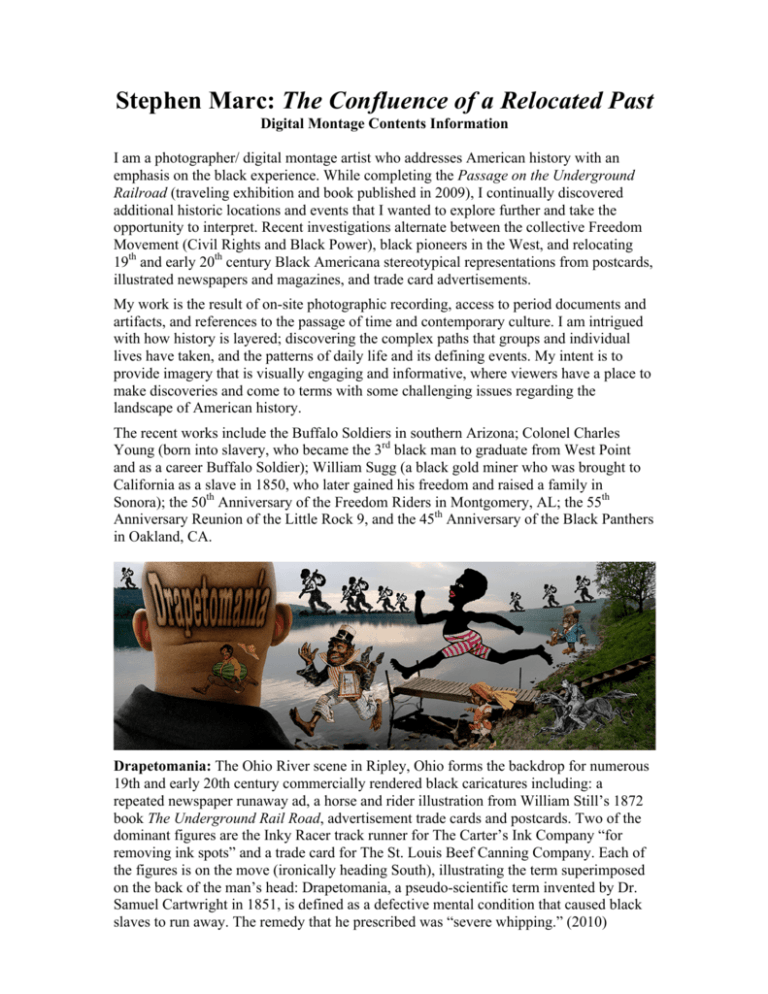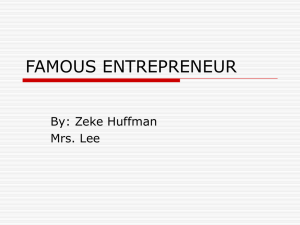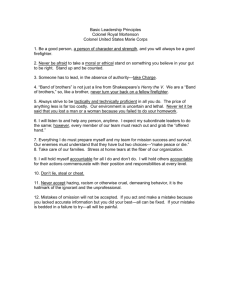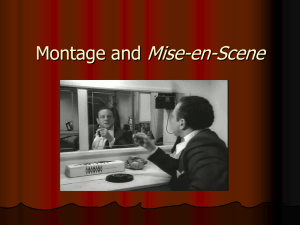Info
advertisement

Stephen Marc: The Confluence of a Relocated Past Digital Montage Contents Information I am a photographer/ digital montage artist who addresses American history with an emphasis on the black experience. While completing the Passage on the Underground Railroad (traveling exhibition and book published in 2009), I continually discovered additional historic locations and events that I wanted to explore further and take the opportunity to interpret. Recent investigations alternate between the collective Freedom Movement (Civil Rights and Black Power), black pioneers in the West, and relocating 19th and early 20th century Black Americana stereotypical representations from postcards, illustrated newspapers and magazines, and trade card advertisements. My work is the result of on-site photographic recording, access to period documents and artifacts, and references to the passage of time and contemporary culture. I am intrigued with how history is layered; discovering the complex paths that groups and individual lives have taken, and the patterns of daily life and its defining events. My intent is to provide imagery that is visually engaging and informative, where viewers have a place to make discoveries and come to terms with some challenging issues regarding the landscape of American history. The recent works include the Buffalo Soldiers in southern Arizona; Colonel Charles Young (born into slavery, who became the 3rd black man to graduate from West Point and as a career Buffalo Soldier); William Sugg (a black gold miner who was brought to California as a slave in 1850, who later gained his freedom and raised a family in Sonora); the 50th Anniversary of the Freedom Riders in Montgomery, AL; the 55th Anniversary Reunion of the Little Rock 9, and the 45th Anniversary of the Black Panthers in Oakland, CA. Drapetomania: The Ohio River scene in Ripley, Ohio forms the backdrop for numerous 19th and early 20th century commercially rendered black caricatures including: a repeated newspaper runaway ad, a horse and rider illustration from William Still’s 1872 book The Underground Rail Road, advertisement trade cards and postcards. Two of the dominant figures are the Inky Racer track runner for The Carter’s Ink Company “for removing ink spots” and a trade card for The St. Louis Beef Canning Company. Each of the figures is on the move (ironically heading South), illustrating the term superimposed on the back of the man’s head: Drapetomania, a pseudo-scientific term invented by Dr. Samuel Cartwright in 1851, is defined as a defective mental condition that caused black slaves to run away. The remedy that he prescribed was “severe whipping.” (2010) Black Panthers: 28th Street at Union Street in Oakland, CA was the site of the April 6, 1968 Black Panther Party shootout with police where Eldridge Cleaver (Minister of Information) was arrested, David Hilliard (Chief of Staff) escaped, and “Lil Bobby” Hutton was killed. Following the shootout in the streets, Hutton and Cleaver took cover in a building that stood in the vacant lot before they surrendered, while Hilliard found shelter in the house, shown in the background of this montage. After surrendering, Hutton was shot and killed. The portraits on the buttons are Cleaver and Hutton, and seated on the right is David Hilliard. (Artifacts courtesy of the Dr. Huey P. Newton Foundation and the California State Library Special Collections. / 2011) Cotton Head: The digitally fragmented structure of the St. Augustine, FL slave market has been combined with a field just outside of Colfax, LA. Embedded in the landscape are: a skipping woman from a Rice’s Seeds trade card (“A Cotton Ball”) ca. 1890, stuffed animals on a utility pole in New Orleans, LA, the male figure detail (originally a couple) from a St. Valentine’s Greeting postcard (“ I loves yer ma honey, yes I do!”) with a 1908 cancellation date (Max Ettinger & Co. Ltd. of London & New York, printed in Saxony from “The Royal Series,” a South Carolina illustration portion of a Native American and African American from the Ballou’s Pictorial (Boston, June, 21, 1856), and a ca. 1920 French boxing toy. (2011) 10th Cavalry: 10th Cavalry Buffalo soldiers relocated to Texas Canyon in Southern Arizona. (photograph courtesy of the Fort Huachuca Museum / 2011) Montgomery Bus Station: Scenes from the Freedom Riders 50th Anniversary Commemoration (May 20, 2011) positioned in front of the historic Greyhound Bus Station that is now the Freedom Rides Museum in Montgomery, AL. Featured in this image are Freedom Riders John Lewis and James Zwerg who survived the mob attack. (2012) Young Memorial) The Presentation of the “Star” Wreath Ceremony (June 5, 2013) in Arlington National Cemetery for Colonel Charles Young. Efforts are underway for him to be posthumously promoted to the rank of general. The event was held on the 90th anniversary of his re-internment in the United States. (He was first buried in Nigeria, where he died on business, while serving his 2nd term at military attaché to Liberia. 2013. Young Porch: Colonel Charles Young and his wife Ada are shown on the porch of their home in Ohio near Wilberforce University where he taught Military Science. Featured in this montage is a large-scale detailed map of Liberia that he drew, a 1914 note that he sent back from Liberia, and one of his uniforms that is housed in the Ohio Historical Society. Colonel Charles Young is buried in Arlington Cemetery. He was one of the three African Americans who graduated from West Point in the 19th century, military attaché to Haiti and Liberia, and served as a career Buffalo Soldier. When he died in 1922, he was the highest-ranking African American in the Regular Army. (2012) Young Gravesite) (2013) Part of the Wreath Laying Ceremony (June 5, 2013) at the grave of Colonel Charles Young in Arlington National Cemetery. Featured among the guest leaving the gravesite is Great Grandson Mr. Dennis Russell and his wife. (2013) Sugg House: This three-montage combination was originally created as a banner for the Tempe Center for the Arts exhibition “Family Matters.” It includes the following components: The home of William and Mary Sugg, a black gold miner who was brought to California in 1850 as a slave, who purchased his freedom for one dollar in 1854. Originally a one-story three-room adobe structure, the house was expanded to a three-story structure as the family grew. There are numbers on the doors of the 2nd floor of the Sugg House, because it was stately enough to serve as a boarding house that handled the overflow from the local hotel. All eleven of their children were born in the main room of the house. William Sugg’s daughter, Melpomene (Babe) is featured in this combination montage in a solo portrait and standing on the side porch of the house with her friend Jessie Mallard. Pictured on the table are photographs of his son Ernest and the “Class of 1924” including grandson Vernon. (2012)






![[Lecture 17] soviet montage 3 for wiki](http://s2.studylib.net/store/data/005394749_1-74b063163f399dbb4123cebb7c05cab3-300x300.png)
